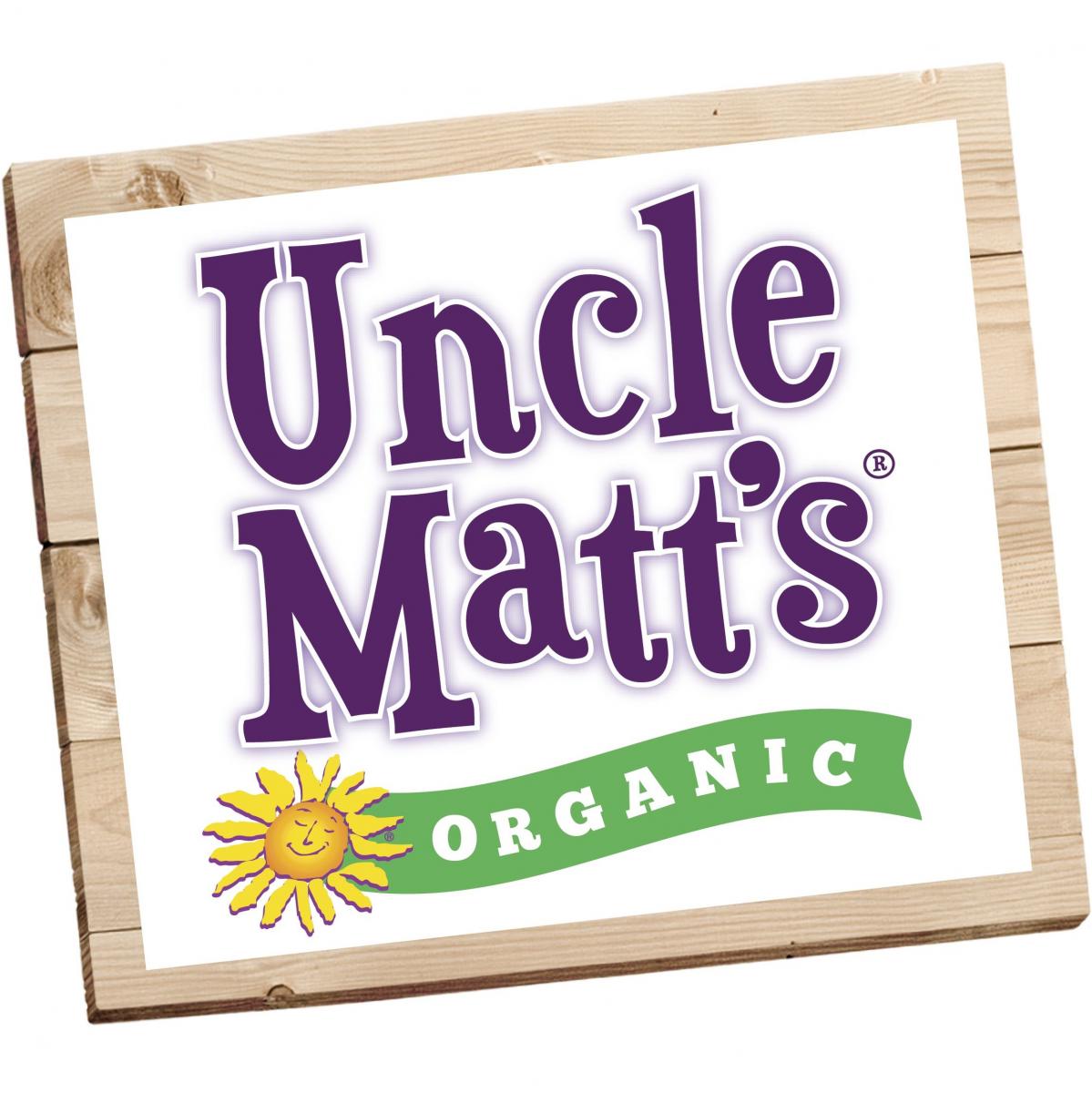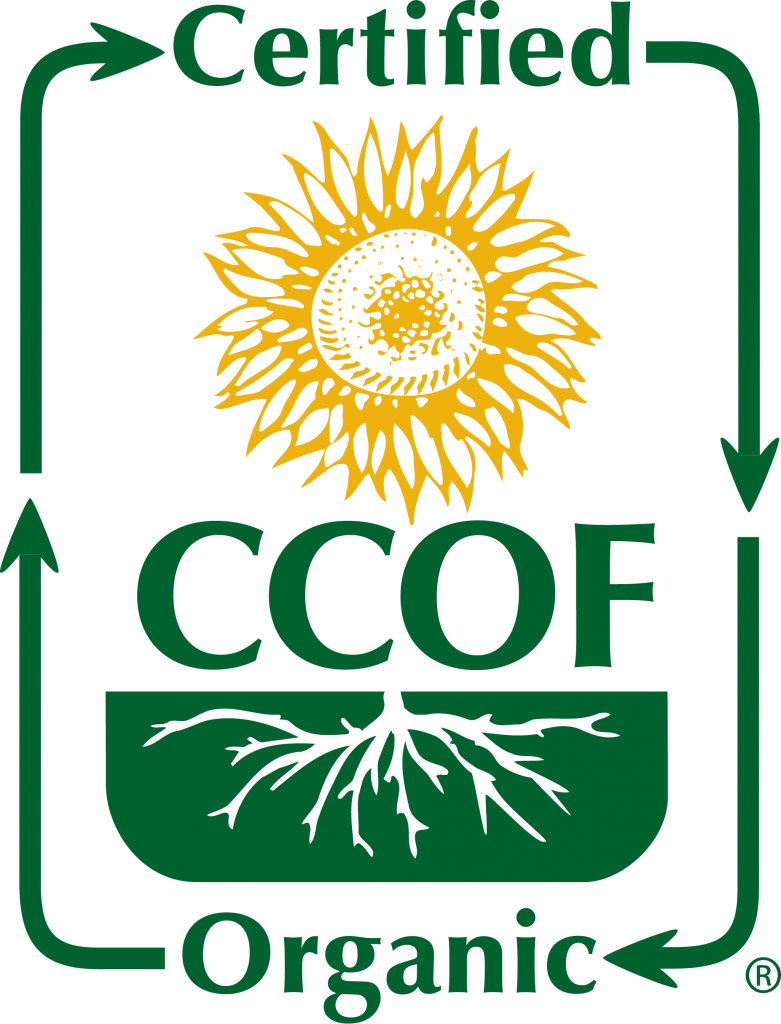2024
June 1, 2024
Project Update: What’s been happening with citrus greening lately?
Citrus greening disease, caused by the bacteria, Candidatus Liberibacter asiaticus, and carried by the insect pest, Asian citrus psyllid (ACP) remains in 2024 as one of the most severe diseases of citrus world-wide. To date, the disease unfortunately continues to impact all citrus varieties, including hybrid trees (UCR), leaving the search for resistant varieties (host plant resistance) a limited tactic for now. Infected trees produce fruits that are bitter, misshapen, and remain green when mature, giving the disease its telltale name.
Citrus greening disease has destroyed millions of acres of citrus crops throughout the United States, reducing citrus production by 70% in Florida alone. Most trees are infected with with citrus greening. There is no remedy or cure for the disease and much of the research on control measures for ACP have focused on conventional protocols, with the exception of the pioneering work from Dr. Jawwad Qureshi’s lab at the University of Florida, in partnership with Texas A&M University.
Dr. Qureshi is working on a three-pronged integrated approach to help organic citrus growers combat the greening disease. Using integrated pest management principles that incorporate biological, cultural, and chemical control tactics, early evidence shows that organic growers implementing the integrated approach can maintain low levels of ACP, the carrier of the disease, to those found in citrus groves with conventional chemical controls.

The following slide taken from an exhibit at 2023 Natural Products Expo East in Philadelphia, one of the largest trade shows in the world to showcase organic products. This graph illustrates that using a multi-pronged approach to pest control including organic insecticides like oils, soaps, and kaolin, along with introducing commercial psyllid predators can suppress ACP to levels comparable to conventional insecticide sprays. This suggests that organic management can be as effective as conventional control.

Commercially available arthropod predators like those illustrated in the slide below allow citrus growers to strengthen their fields with biological control agents for non-chemical management of ACP, along with naturally occurring arthropod predators and commercially available entomopathogens (fungal pathogens that infect and kill ACP).

What’s next?
In 2024, the team plans to confront troublesome citrus greening disease further by continuing to fine tune year-round management strategies for ACP. After preliminary experiments led to the discovery that a combination of kaolin clay and thyme essential oil aid in the best repellency of ACP as an organic chem labs plan to conduct further investigations of this tactic under field conditions.
The team also plans to closely monitor which predators have “more bounce for the ounce” or the highest value in bringing down psyllid numbers along with the effectiveness of releases of a Florida-established subtropical Asian parasitoid (Tamarixia radiata) as part of an integrated biological control approach. Further replication of field experiments that examine the effectiveness of excluding ants that protect ACPs for their sugary “honeydew” waste left on citrus shoots, these ants act as soldiers that impede biological predators and control, as well as the benefit of attractive lures for recruiting beneficial insects.
The team will also explore the effectiveness of using UV-metalized reflective mulch on ACP and citrus trees, which will complete the “third prong” of the integrated pest management approach.
Lastly, the team plans to make head way and complete their partial budget analysis as part of their economic assessment for California and Florida organic citrus production, including the cost benefit of trunk injection as a cultural practice. The economics team aims to incorporate past findings to improve survey methods in 2024.
Dr. Qureshi’s team continues to develop and disseminate outreach materials for management of ACP and citrus greening disease through grower meetings and online seminars. Partnership with The Organic Center outreach on the project aids in distributing information about the project to an organic audience through its newsletters and social media channels. Dr. Qureshi’s recent presentation at Natural Products Expo East in 2023 offered an opportunity for an interactive in-person exhibit in educating and engaging the public and organic industry.
March 15, 2024
The Organic Center and Organic Voices showcase organic's finest at Natural Products Expo West in Anaheim, CA
The best of organic – from innovative entrepreneurs and established organic brands to cutting-edge organic research and visionary scientists – were honored at organic’s premier event at the Natural Products Expo West trade show in Anaheim, California.
Over 750 attendees were hosted by The Organic Center and Organic Voices, “An Organic Night Out: Honoring the Year’s Best in Organic” on March 13 recognizing and celebrating the success of organic brands and companies in communicating the impact of organic to consumers, as well as showcase the latest organic research being conducted by The Organic Center and its partner scientists.
The honorees at the first-ever “Organic Oscars” – all nominated and chosen by their peers – reflected the huge diversity of today’s organic sector. Over 70 organic companies have nominated more than a hundred organic businesses and champions: organic farmers of all sizes producing everything from dairy products to wine; organic makers of meats, chocolate, spices, coffee and more; and organic entrepreneurs marketing dog treats, vitamins, baby blankets and mattresses! Groundbreaking organic research was honored with an Excellence Award going to the most impactful organic research of the year.
Award-winning actress, philanthropist, and co-founder of the organic, next-generation children's nutrition company Once Upon a Farm, Jennifer Garner, emceed the awards ceremony with organic visionary, advocate, and co-founder of the world’s largest organic dairy company Stonyfield Farm, Gary Hirshberg.
Celebrating the science behind organic
“To grow the organic industry and its positive impact on people and the planet, we all must understand the value of organic and the holistic benefits when we buy products carrying the USDA Organic seal. This event showcases the brilliant science that demonstrates those benefits and helps organic farmers succeed,” said Dr. Amber Sciligo, Director of Science Programs for The Organic Center. “The celebration of leaders in the organic industry, in combination with the spotlight on the latest organic research, promises a meaningful and unforgettable evening.”
The evening featured an interactive science fair demonstrating research being conducted by The Organic Center and other scientists including Dr. Qureshi's team working on organic solutions to citrus greening. Attendees saw first-hand the real benefits organic practices have on crop production and the health of our planet and people. Displays showed how organic farming protects the health of our pollinators with a live bee observation hive, how choosing organic cotton is good for our environment, how the organic industry is leading the charge to tackle the devastating citrus greening disease without the use of toxic chemicals, and how organic farming helps protects consumers against contamination of pesticides, antibiotics and synthetic growth hormones in their milk and dairy products.
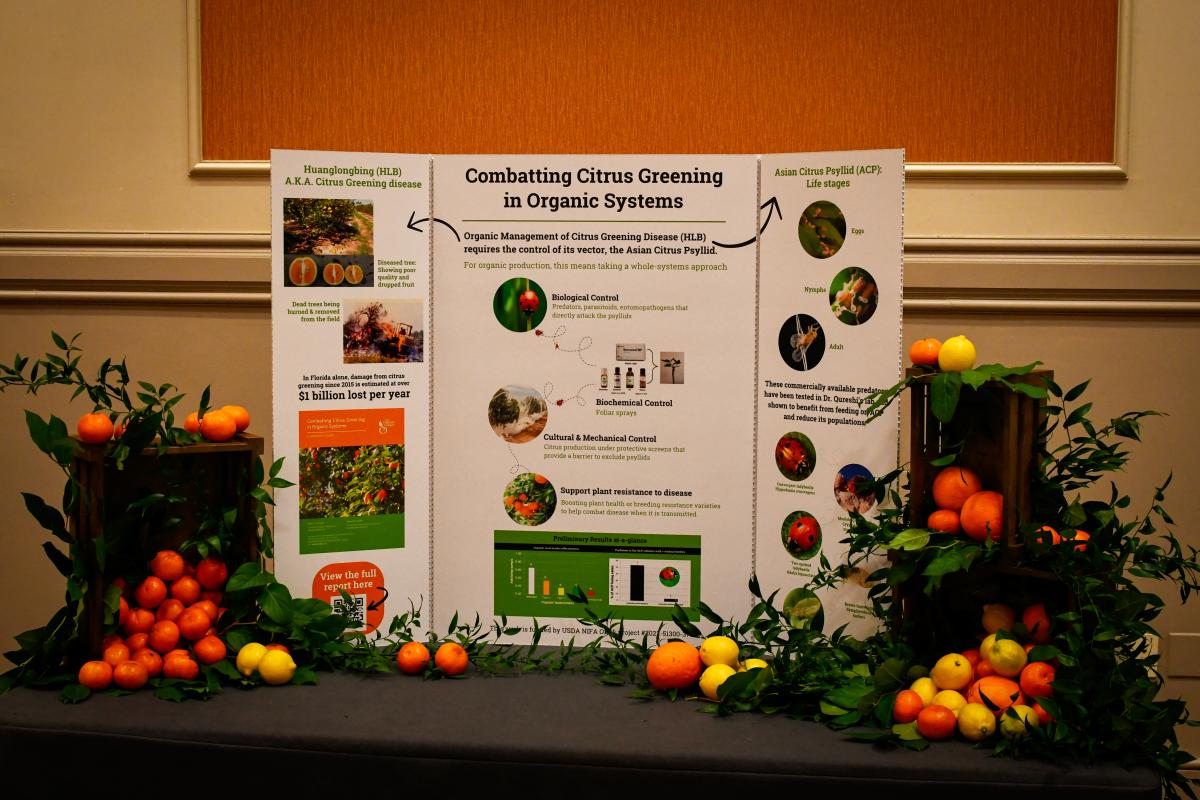
2023
Preliminary experiments by PhD Student Romain Exilien in Dr. Xavier Martini's lab, University of Florida, find that red-colored kaolin can be more repellent against the Asian citrus psyllid (D. citri), which spreads citrus greening disease. Additional experiements suggest that when essential oils like thyme and coriander are mixed with the kaolin, the repellent effects are amplified:
Plant-Based Essential Oils and Kaolin to Control the Asian Citrus Psyllid Population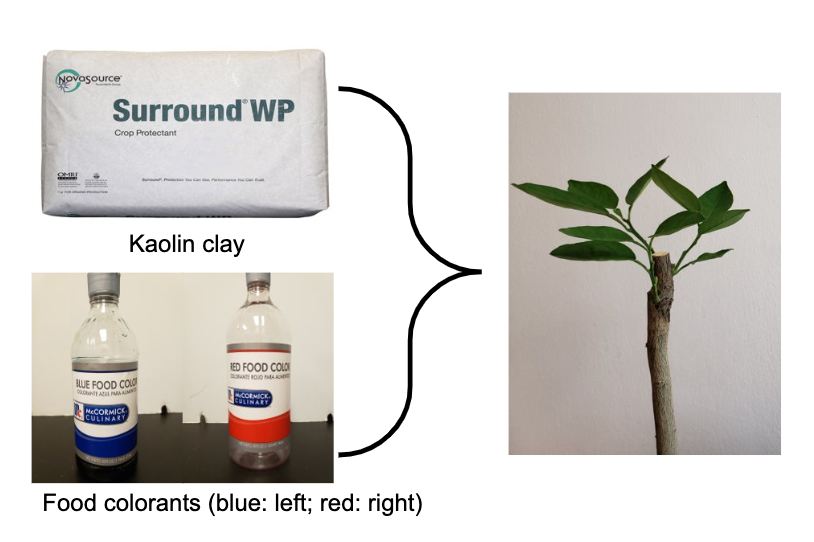
Experiment #1:
The goal of the study is to determine if colored kaolin, a type of clay used to repel target pests and prevent them from penetrating plant tissue, is more repellent than white kaolin. The researchers focused on citrus plants that were reared in a greenhouse or at the North Florida Research and Education Center (NFREC). They prepared a mixture of kaolin with water (at a concentration of 75 g per liter) and added a surfact (at a concentration of 1%), which helps the mixture combine, and food colorants (13 ml) to create colored kaolin. The colored kaolin was applied to the plants a few hours before the experiment.
Dual Choice Test: The experiment consisted of three treatments and control, each with five replicates: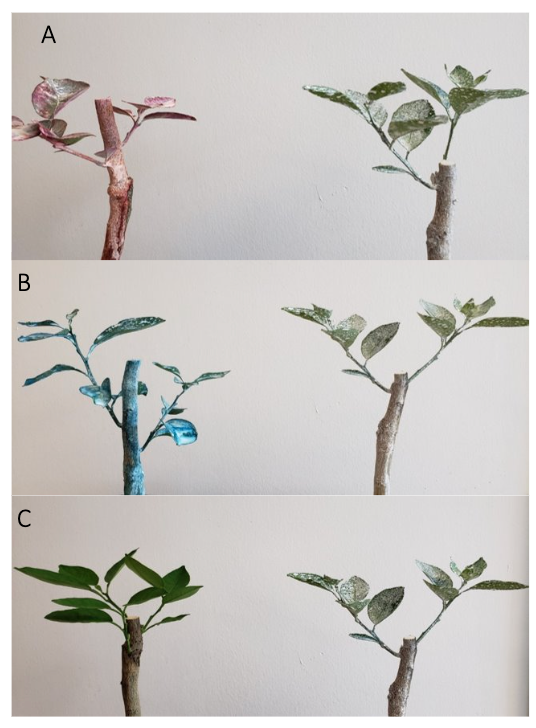
A) The first treatment compared the effectiveness of kaolin mixed with red food colorant (K+R) versus plain kaolin (K).
B) The second treatment compared the effectiveness of kaolin mixed with blue food colorant (K+B) versus plain kaolin (K).
C) The third treatment compared the effect of not applying any kaolin to the plants versus applying plain kaolin (K).
D) The control group compared the effect of not applying any kaolin to the plants in both the treatment and control groups (positive control).
The purpose of these treatments was to compare the repellent properties of different combinations of kaolin and food colorants, as well as to evaluate the effectiveness of kaolin as a repellent by comparing it to a control group with no kaolin application.
Climate chamber (21±1 °C, 60-81% R.H., 14L:10D photoperiod): The data collected in the experiment includes the number of D. citri (Asian citrus psyllid)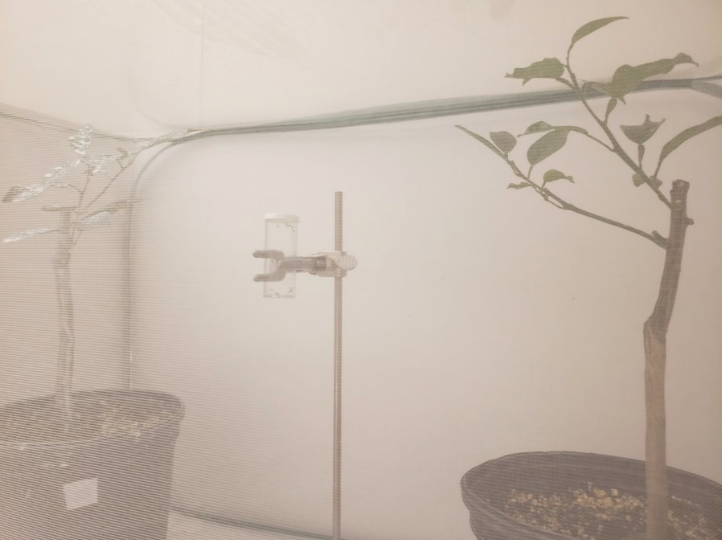 settled on each plant at 4, 8, and 12 hours after their release during a 72-hour period. Additionally, the number of D. citri eggs per plant was recorded on the 7th day.
settled on each plant at 4, 8, and 12 hours after their release during a 72-hour period. Additionally, the number of D. citri eggs per plant was recorded on the 7th day.
Results: The data shows that there were fewer Asian citrus psyllids (D. Citri) settled on plants that were coated with red-colored kaolin compared to plants coated with regular kaolin. This suggests that the red colored kaolin had a repellent effect on the D. Citri population.
Additionally, the data indicates that there were fewer D. Citri settled on plants coated with regular kaolin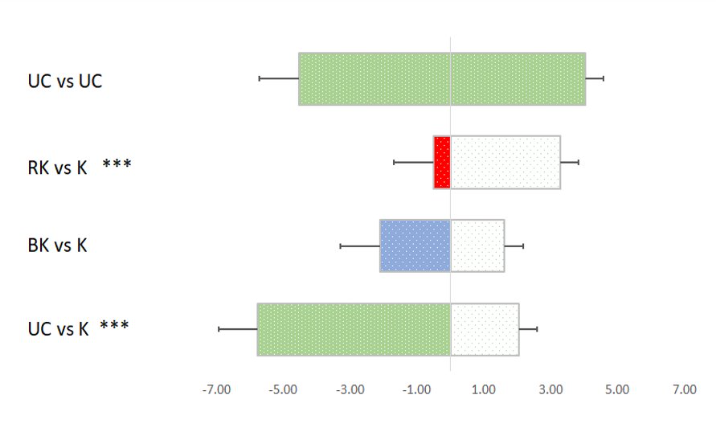 compared to plants without any kaolin coating. This suggests that kaolin, regardless of color, has a repellent effect on the D. Citri population.
compared to plants without any kaolin coating. This suggests that kaolin, regardless of color, has a repellent effect on the D. Citri population.
Furthermore, the data shows that there was no significant difference in the number of D. Citri settled on plants coated with blue colored kaolin compared to plants coated with white kaolin. This indicates that the color of the kaolin did not have a significant impact on the repellent effect against D. Citri settlement.
Overall, these findings suggest that both regular kaolin and red colored kaolin are effective in reducing D. Citri settlement on citrus plants, while the color of the kaolin may not play a significant role in its repellent properties
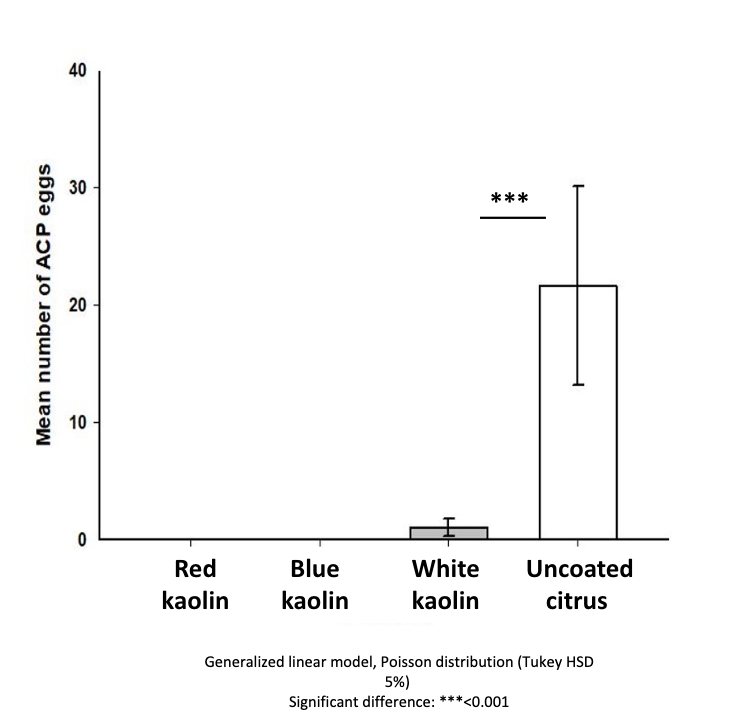
The number of D. Citri Eggs Laid/Plant: The data indicates a significant variation between the treatments. Specifically, it was observed that no eggs were laid on plants coated with colored kaolin.
Experiment #2:
The goal of this study is to investigate the additive effect of essential oils combined with kaolin. The experiment is scheduled to take place in May 2023. The procedures for this experiment are expected to be similar to those used in Experiment #1. In this experiment, a mixture will be prepared using kaolin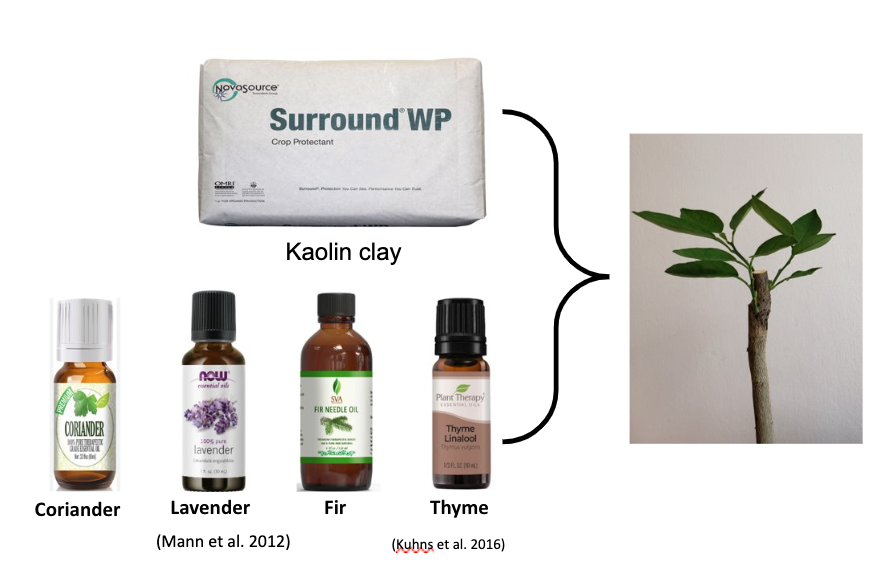 and essential oil. The kaolin will be mixed with water at a concentration of 75g per liter, and essential oil will be added at a concentration of 1% as well as tween will be included in the mixture at a concentration of 1%. The purpose of this experiment is to evaluate the combined effect of essential oils and kaolin as a potential treatment or repellent against a particular target pest. By investigating the additive effect of these components, the teams aims to determine if their combination enhances the effectiveness of kaolin or provides any additional benefits.
and essential oil. The kaolin will be mixed with water at a concentration of 75g per liter, and essential oil will be added at a concentration of 1% as well as tween will be included in the mixture at a concentration of 1%. The purpose of this experiment is to evaluate the combined effect of essential oils and kaolin as a potential treatment or repellent against a particular target pest. By investigating the additive effect of these components, the teams aims to determine if their combination enhances the effectiveness of kaolin or provides any additional benefits.
Dual Choice Test: the experiment consisted of four treatments and control, each with four replicates: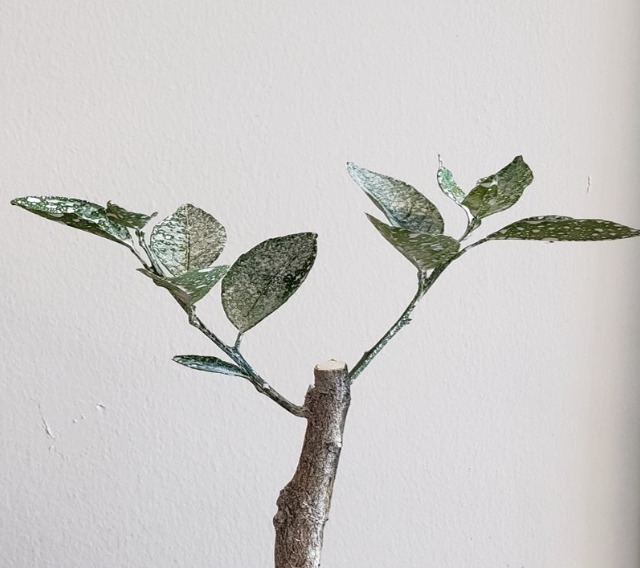
The data consists of five treatments and a control group, each with an application of kaolin and various essential oils:
A) The first treatment compares the effectiveness of kaolin combined with coriander oil (K+C) versus plain kaolin (K).
B) The second treatment compares the effectiveness of kaolin combined with lavender oil (K+L) versus plain kaolin (K).
C) The third treatment compares the effectiveness of kaolin combined with thyme oil (K+T) versus plain kaolin (K).
D) The fourth treatment compares the effectiveness of kaolin combined with fir oil (K+F) versus plain kaolin (K).
E) The control group involves the application of plain kaolin (K) against another group with the same application of plain kaolin (K).
20 sexed ACP (10 ♂ + 10 ♀)/cage: The data collected in this study includes the number of D. citri (Asian citrus psyllid) settled on each plant at 4, 8, and 12 hours during a three-day period. Additionally, the number of D. citri eggs per plant was recorded on the 7th day.
This data provides information on the population dynamics? of D. citri and their settlement behavior on the plants at different time points over a three-day period. By observing the number of settled psyllids, the team can gain insights into their colonization patterns and activity levels.
Furthermore, the number of eggs per plant on the 7th day indicates the reproductive success of the D. citri population. This data can be used to evaluate the impact of the psyllids on the plants and assess the effectiveness of the treatments or control measures in managing their population.
Overall, this data helps in understanding the behavior and reproductive potential of D. citri, which is crucial for developing strategies to control their population and mitigate their impact on citrus plants.
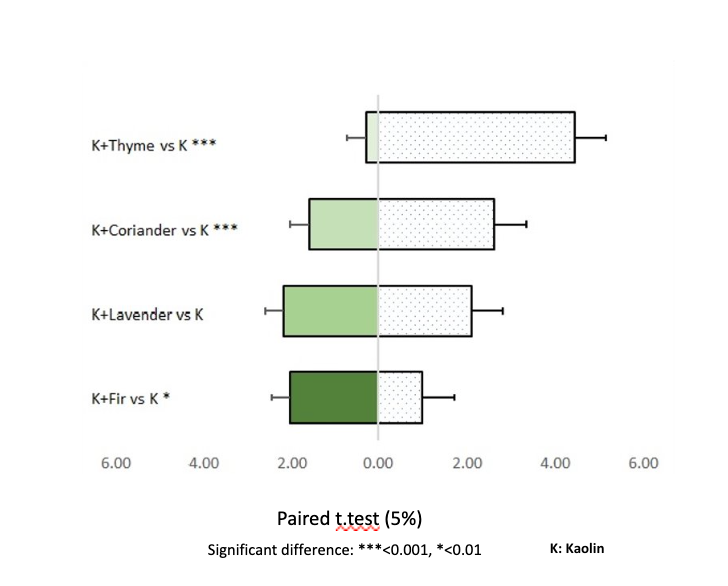 Preliminary Results: The data indicates that there were fewer Asian citrus psyllids (D. Citri) settled on plants coated with kaolin combined with thyme and kaolin combined with coriander, compared to plants coated with kaolin alone. It was also observed that fewer D. Citri settled on plants coated with kaolin alone, as opposed to plants coated with kaolin combined with fir. However, there was no significant difference in the number of D. Citri settled on plants coated with kaolin alone compared to plants coated with kaolin combined with lavender. These findings suggest that the combination of kaolin with thyme or coriander may have enhanced the repellent effect against D. Citri settlement, while kaolin alone also demonstrated some repellent properties. On the other hand, the addition of fir to kaolin did not appear to have a significant impact on reducing D. Citri settlement.
Preliminary Results: The data indicates that there were fewer Asian citrus psyllids (D. Citri) settled on plants coated with kaolin combined with thyme and kaolin combined with coriander, compared to plants coated with kaolin alone. It was also observed that fewer D. Citri settled on plants coated with kaolin alone, as opposed to plants coated with kaolin combined with fir. However, there was no significant difference in the number of D. Citri settled on plants coated with kaolin alone compared to plants coated with kaolin combined with lavender. These findings suggest that the combination of kaolin with thyme or coriander may have enhanced the repellent effect against D. Citri settlement, while kaolin alone also demonstrated some repellent properties. On the other hand, the addition of fir to kaolin did not appear to have a significant impact on reducing D. Citri settlement.
Partial conclusion: The data suggests that colored kaolin is an effective visual repellent against Asian citrus psyllids (D. Citri) as it prevents them from settling and laying eggs on plants.
Furthermore, the combination of kaolin with thyme and coriander has shown to be more effective in repelling D. Citri compared to kaolin alone. This indicates that the addition of thyme and coriander enhances the repellent properties of kaolin, resulting in a greater deterrent effect on D. Citri settlement and oviposition.
Overall, these findings emphasize the potential of using colored kaolin as a visual repellent and highlight the beneficial effects of combining specific essential oils, such as thyme and coriander, with kaolin to improve its repellent effectiveness against D. Citri.
2022
USDA OREI program awards just over $2,000,000 to fund research on organic solutions to citrus greening!
The grant awards $2,032,887 to a team of scientists from the University of Florida, Texas A&M University, and The Organic Century led by Dr. Jawwad Qureshi, Associate Professor of Entomology at the University of Florida, for a 4-year project. The team will be focused on providing organic citrus growers nationwide with vital tools to reduce and manage the spreading of citrus greening, also known as Huanglongbing disease (HLB), in their groves.
For more information on this project see the Press Release here.

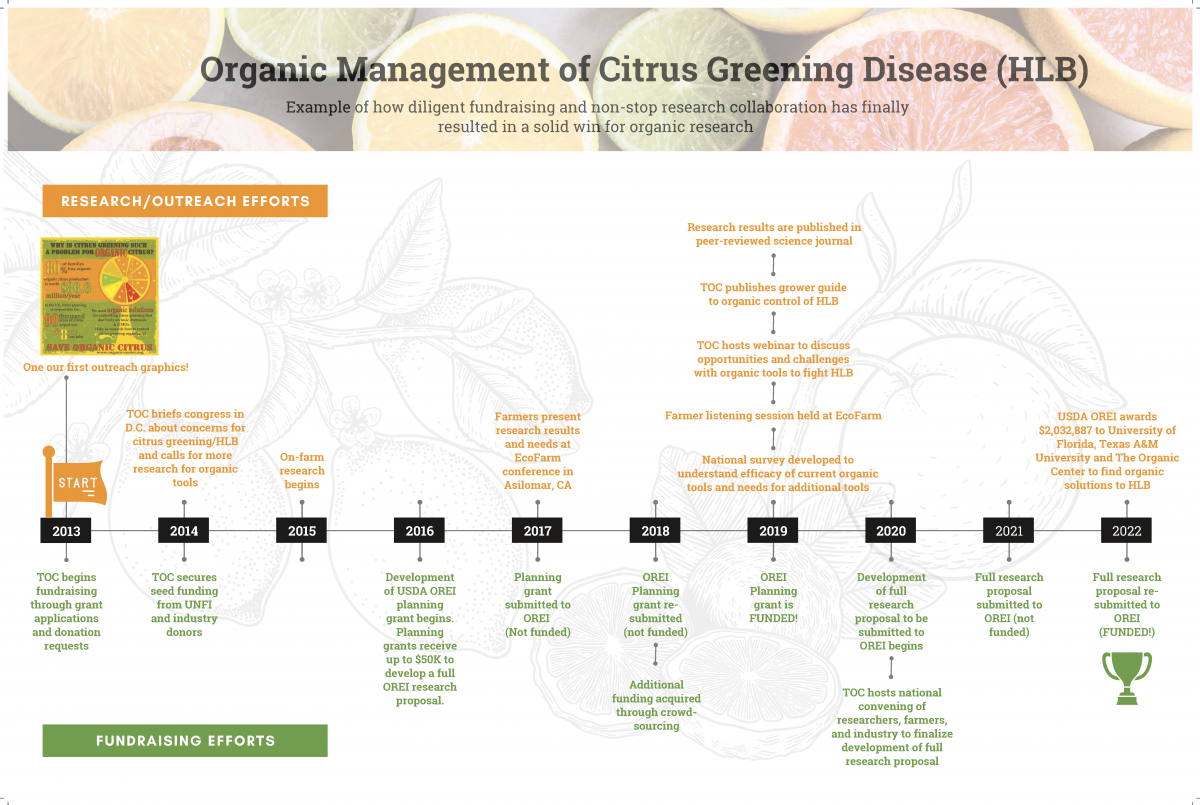
2020
Fill out the survey to help find organic solutions to citrus greening
We need help from organic citrus stakeholders to find solutions to citrus greening. We will use the information to develop a large-scale holistic research project proposal targeted toward protecting organic citrus growers from citrus greening, slowing the spread, and reducing damage to currently infected groves. We need your help: fill out the survey here!
Listening Session at EcoFarm
Date: Thursday January 23rd 2020
Time: 2-3pm
Location: Sanderling
Come be a part of developing a research project focused on providing much-needed knowledge and relief to organic citrus growers! This discussion group will address the challenges associated with growing organic citrus in the face of citrus greening. We will discuss concerns around citrus greening, experiences with materials and non-chemical methods of preventing or controlling the Asian citrus psyllid and the HLB bacterial infection, and research that is most needed for growers across citrus growing regions in the United States. This project is part of an OREI planning grant that was recently awarded from the USDA to a team including non-profits, academic researchers, and governmental agencies. The information from this listening session will be used to develop a large-scale holistic project proposal targeted toward protecting organic citrus growers from citrus greening, slowing the spread, and reducing damage to currently infected groves.
2019
Citrus Planning Grant Funded
The University of Florida and The Organic Center were awarded a planning grant to conduct a needs assessment through a survey and workshop that will gather information on current organic-compliant strategies used to combat HLB, their successes and challenges. Learn more about the project here!
Upcoming Webinar: Citrus Greening & the Quest for an Organic Solution, May 9, 2019 at 2pm ET
Citrus Greening is a devastating disease affecting citrus around the world. It has swept through the United States, wiping out over 60% of the citrus harvest in Florida alone. To date there has been no cure found for this disease, and most of the research on control measures have focused on conventional protocols. However, a new report by the Organic Center in collaboration with Ellen Cochrane, examines tools that are available for organic growers and details a rigorous, multi-faceted approach to protecting citrus trees in organic systems, while identifying future needs to help save organic and conventional citrus alike. Join Dr. Amber Sciligo, Science Program Manager at The Organic Center, and Ellen Cochrane on Thursday, May 9 at 2:00 P.M. ET for a one-hour webinar as our presenters discuss the effect Citrus Greening disease has had on the Florida citrus industry, especially in organic, and provide a high-level overview of the study’s findings.
Watch the recorded webinar on demand here.
Organic Control Protocols Published!
Our paper detailing allowable methods for combating citrus greening in organic groves has been published in a peer-reviewed publication, along with an accompanying grower guide for organic citrus producers.
2018
Crowdfunding Campaign a success!
The Organic Center concluded a successful Crowdfunding Campaign, and exceeded its crowdfunding goal of $15,000, reaching a total of $20,417. The campaign was so compelling that A&E Television Network funded it, choosing it from among thousands of other crowdfunding campaigns.
2017
Farmer Presentations
The Organic Center has been invited to give presentations at several industry and farmer events around the country. For example, we provided and in-depth presentation at the 2017 EcoFarm Conference in Ascilomar, CA; the 2017 Organic Food and Farming Summit in Gainesville, FL; the 2017 Biocontrols Conference in Orlando, FL; and the 2016 OTA Policy Conference in Washington, D.C.
Media Coverage
Read some of the stories that feature our work:
Policy Makers
The Organic Center conducted a briefing for congress, which was well attended and generated substantial interest from policy makers. Staff members from several U.S. congressional offices gathered to hear the Organic Center’s progress on finding safe and effective ways to fight off citrus greening disease without the use of dangerous synthetic pesticides, and how their districts were impacted by the threat of the disease.







 settled on each plant at 4, 8, and 12 hours after their release during a 72-hour period. Additionally, the number of D. citri eggs per plant was recorded on the 7th day.
settled on each plant at 4, 8, and 12 hours after their release during a 72-hour period. Additionally, the number of D. citri eggs per plant was recorded on the 7th day.  compared to plants without any kaolin coating. This suggests that kaolin, regardless of color, has a repellent effect on the D. Citri population.
compared to plants without any kaolin coating. This suggests that kaolin, regardless of color, has a repellent effect on the D. Citri population. 
 and essential oil. The kaolin will be mixed with water at a concentration of 75g per liter, and essential oil will be added at a concentration of 1% as well as tween will be included in the mixture at a concentration of 1%. The purpose of this experiment is to evaluate the combined effect of essential oils and kaolin as a potential treatment or repellent against a particular target pest. By investigating the additive effect of these components, the teams aims to determine if their combination enhances the effectiveness of kaolin or provides any additional benefits.
and essential oil. The kaolin will be mixed with water at a concentration of 75g per liter, and essential oil will be added at a concentration of 1% as well as tween will be included in the mixture at a concentration of 1%. The purpose of this experiment is to evaluate the combined effect of essential oils and kaolin as a potential treatment or repellent against a particular target pest. By investigating the additive effect of these components, the teams aims to determine if their combination enhances the effectiveness of kaolin or provides any additional benefits. 
 Preliminary Results: The data indicates that there were fewer Asian citrus psyllids (D. Citri) settled on plants coated with kaolin combined with thyme and kaolin combined with coriander, compared to plants coated with kaolin alone. It was also observed that fewer D. Citri settled on plants coated with kaolin alone, as opposed to plants coated with kaolin combined with fir. However, there was no significant difference in the number of D. Citri settled on plants coated with kaolin alone compared to plants coated with kaolin combined with lavender. These findings suggest that the combination of kaolin with thyme or coriander may have enhanced the repellent effect against D. Citri settlement, while kaolin alone also demonstrated some repellent properties. On the other hand, the addition of fir to kaolin did not appear to have a significant impact on reducing D. Citri settlement.
Preliminary Results: The data indicates that there were fewer Asian citrus psyllids (D. Citri) settled on plants coated with kaolin combined with thyme and kaolin combined with coriander, compared to plants coated with kaolin alone. It was also observed that fewer D. Citri settled on plants coated with kaolin alone, as opposed to plants coated with kaolin combined with fir. However, there was no significant difference in the number of D. Citri settled on plants coated with kaolin alone compared to plants coated with kaolin combined with lavender. These findings suggest that the combination of kaolin with thyme or coriander may have enhanced the repellent effect against D. Citri settlement, while kaolin alone also demonstrated some repellent properties. On the other hand, the addition of fir to kaolin did not appear to have a significant impact on reducing D. Citri settlement.


